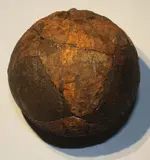A2coins
Ruby Member
Amazing thanks for sharing this

Tom, be very careful if it is still loaded...while the soak has been going on for a while, (perhaps it as never changed?) especially since you still not salt everywhere..I never trust that stuff...seen far too many cannon and weapons explode from the reaction. I'd rather have it out of there than wonder if it will ever go off.
You can dissolve the saltpeter in the blackpowder mix with a steam spray. I have used a water dental pick that a dentist uses to remove solid blackpowder, just feed it with boiling water. These water picks are actually quite handy for restoration work, as one can imagine, getting between teeth, in fact many dental tools are helpful.
(Acetone will create a hard film.)
Good luck. Keep posting!







I guess that is bad news / good news Tom ? Now it will have your own "personal" touch to it. You will make it good again !

Crystalline structure of cast iron:
View attachment 1651873
They would have kept these heated in the mold for a while to let the crystalline structure grow. The combination of ductile and brittle structure would let it blow apart and fragment, rather than just in half or powder.
Look at the way it fell apart, a perfect grenade! (at least you know you have all of the pieces. This could be valuable research information or for recovery/archeological operations, one knows they have grenade fragments, and to look for more, not just toss the pieces.
This one seems to be of much different construction than the last one. (2 pieces brazed together) I dont see that structure in this one. Same timeframe and/or location?
Too bad all of this knowledge of metal working, black smithing and gold smithing have been lost. We probably would have a difficult time recreating these today.
Good luck.
..........I really hope you get a chance to PXRF the fragments. ............There are many of these devices in use in Germany, especially in the environmental business, used to identify cleanup of heavy metal contamination. Perhaps find one ans ask then to shoot it for you.
Thanks again for sharing your incredible work.
Did you get a species ID on the wooden plugs Tom?
Tom,
When you cool a metal quickly, the crystalline structure does not have a chance to form. What you are doing is really great to advance the understanding of metallurgy and forging of the day, and to identify different techniques of manufacture.
The brazing may have required them to preheat the 2 sides, perhaps on purpose, or inadvertently forming a better fragmentation matrix.
I really hope you get a chance to PXRF the fragments. I am willing to bet with that structure, you will find they were adding some graphite to the mix. There are many of these devices in use in Germany, especially in the environmental business, used to identify cleanup of heavy metal contamination. Perhaps find one ans ask then to shoot it for you.
Thanks again for sharing your incredible work.
Xaos, is this device used to determine the elemental composition of a metal or alloy?
If so, scrap metal recycling centers or even Pawn shops might have one they might be willing to use on it.
Hi Buddy,
there are only a few people here who got this new 40.000$ XRF machines and they asking too high prices for analyses. Also most has the machines programmed on stuff they researching. So far I heard, there are basic versions (who can detect everything) but you have to by special expensive programs who can real detect all elements.
In for updates on leather pouch and broken grenade!

